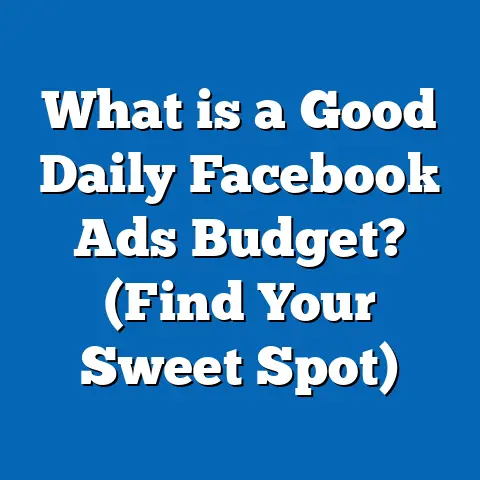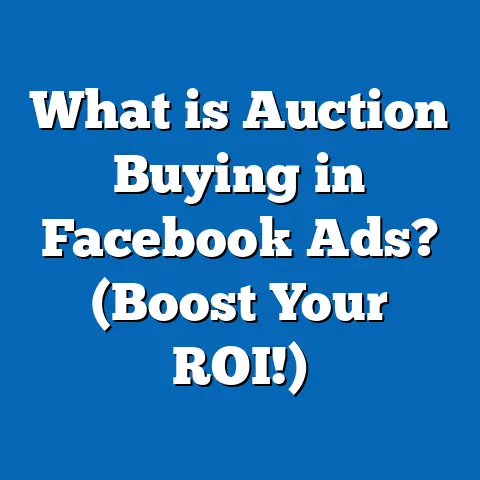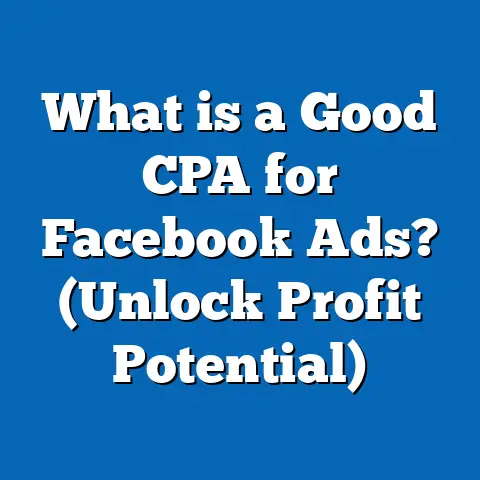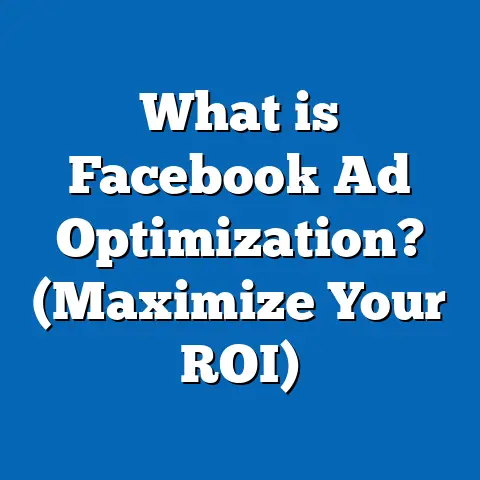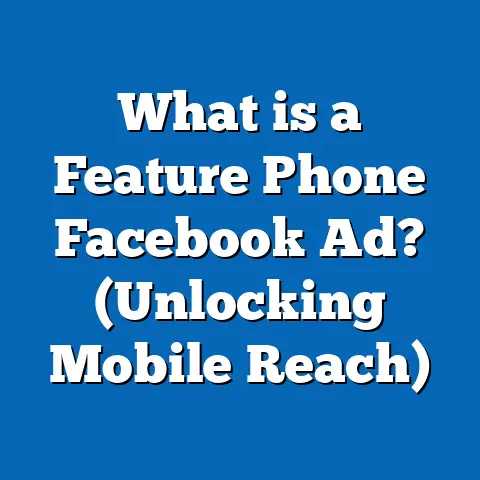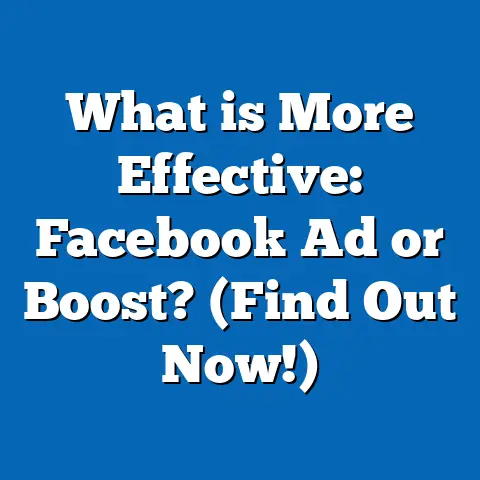What is a Good Facebook Ad Conversion Rate? (Unlocking Success)
What is a Good Facebook Ad Conversion Rate? (Unlocking Success)
Introduction: The Facebook Ad Conversion Rate Phenomenon in Pop Culture
Remember when “Gangnam Style” swept the globe, hitting billions of views seemingly overnight? That viral explosion wasn’t just luck—it was a perfect storm of catchy content, timing, and massive sharing. In many ways, Facebook ads offer a similar potential for businesses: the opportunity to reach millions and convert casual browsers into loyal customers. But unlike viral videos, success with Facebook ads hinges on understanding a crucial metric—the conversion rate.
Every marketer wants their ad to “go viral” or at least perform well. Yet, the real measure of success is conversion—the percentage of users who take the action you want them to after seeing your ad. Whether that’s purchasing a product, signing up for a newsletter, or downloading an app, conversion rate is the heartbeat of your campaign’s effectiveness.
Understanding Facebook Ad Conversion Rate
What is a Facebook Ad Conversion Rate?
At its core, the Facebook ad conversion rate measures how many people complete your desired action after engaging with your ad.
Conversion could mean varied things depending on your campaign goal:
- Making a purchase
- Filling out a lead form
- Signing up for a webinar
- Downloading an eBook or app
- Subscribing to a newsletter
The formula for conversion rate is straightforward: Conversion Rate=(Number of ConversionsNumber of Clicks)×100\text{Conversion Rate} = \left(\frac{\text{Number of Conversions}}{\text{Number of Clicks}}\right) \times 100
For instance, if 1,000 people click an ad and 50 complete the purchase, your conversion rate is: 501000×100=5%\frac{50}{1000} \times 100 = 5\%
Why Conversion Rate Matters More Than Clicks or Impressions
Clicks and impressions are vanity metrics—they show interest but not action. Conversion rate tells you whether your message and offering are compelling enough to make users act.
Consider two ads:
- Ad A has 10,000 clicks and 100 conversions (1% conversion rate).
- Ad B has 2,000 clicks and 150 conversions (7.5% conversion rate).
Ad B is more effective despite fewer clicks because it drives more meaningful results.
Facebook Conversion Rate Benchmarks: How Do You Compare?
Industry Benchmarks and Variations
Facebook ad conversion rates differ dramatically by industry due to variations in customer behavior, sales cycles, and product types.
| Industry | Average Conversion Rate (2024) | Notes |
|---|---|---|
| E-commerce | 9.21% | Highly competitive; impulse buys |
| Real Estate | 2.47% | High-value purchases; longer decision |
| Finance | 10.41% | Trust-based; requires credibility |
| Education | 11.45% | Often involves lead generation |
| B2B Services | 10.27% | Longer sales cycle; relationship-driven |
| Health & Fitness | 14.29% | High engagement; strong emotional pull |
These averages serve as starting points. Factors such as ad quality, targeting precision, and landing page experience can push your conversion rate above or below these benchmarks.
Additional Data Points
- According to a 2023 study by AdEspresso, video ads on Facebook have a conversion rate 34% higher than image ads.
- Retargeting campaigns can boost conversion rates by up to 70% compared to cold audience campaigns.
- Mobile users account for over 94% of Facebook ad impressions but often have slightly lower conversion rates compared to desktop due to smaller screens and distractions.
What Influences Your Facebook Ad Conversion Rate?
Audience Targeting: The Foundation of Conversion Success
Facebook offers incredibly detailed targeting options:
- Demographics (age, gender, location)
- Interests and behaviors
- Custom Audiences (based on your existing customer data)
- Lookalike Audiences (people similar to your best customers)
Targeting the right people improves relevancy and conversion rates dramatically. For example:
- A shoe company targeting runners will see higher conversions than one targeting all adults.
- A B2B software company will convert better focusing on job titles like “Marketing Manager” rather than broad industries.
Ad Creative: Visuals Speak Louder Than Words
Your ad creative—images, videos, headlines—needs to capture attention instantly and communicate value.
- Videos showing product usage have higher engagement.
- Clear call-to-action buttons like “Shop Now” or “Sign Up” increase conversions.
- Consistent branding builds trust over time.
Landing Page Experience: The Conversion Gateway
Even the best ad can fail if the landing page is poor:
- Slow loading times cause visitors to bounce.
- Confusing layouts reduce form fills or purchases.
- Lack of mobile optimization alienates the majority of users.
Optimized landing pages aligned with the ad’s message increase trust and conversions.
Offer Quality: Value Drives Action
Discounts, free trials, exclusive content—these incentives raise perceived value and conversion likelihood.
Ad Format: Choosing What Works Best
Facebook supports multiple formats:
- Carousel ads showcasing multiple products.
- Collection ads for immersive shopping experiences.
- Lead ads simplifying form fills inside Facebook.
- Dynamic ads automatically retargeting with relevant products.
Selecting the right format for your goal influences conversion rates.
Real World Case Studies: How Brands Improved Their Conversion Rates
Case Study 1: Apparel Brand Increases Conversion by 30% via Audience Segmentation
Background: An online fashion retailer ran generic ads targeting broad demographics with static images.
Challenge: Low conversion rates (~5.2%) despite high impressions.
Action Taken:
- Created lookalike audiences based on past purchasers.
- Developed personalized video ads highlighting seasonal collections.
- Optimized landing pages for mobile shopping ease.
Results: Conversion rates jumped to 6.8%, a 30% improvement translating into significant revenue growth.
Insight: Precise audience targeting combined with engaging creatives drives better ROI.
Case Study 2: SaaS Company Doubles Conversions by Improving Landing Pages
Background: A SaaS company offering project management software noticed low sign-up rates despite high ad clicks.
Challenge: Users dropped off after clicking ads.
Action Taken:
- Redesigned landing page for clarity with simpler forms.
- Added customer testimonials and trust badges.
- Increased page speed and mobile responsiveness.
Results: Conversion rate increased from 3.1% to 7.5%.
Insight: A seamless user journey post-click is critical in converting interest into action.
Case Study 3: Local Gym Uses Retargeting to Boost Membership Sign-Ups
Background: A fitness center struggled to convert first-time website visitors into members.
Challenge: Initial campaigns had high traffic but low sign-ups (2%).
Action Taken:
- Implemented Facebook Pixel for retargeting.
- Created retargeting campaigns offering limited-time discounts.
- Used video testimonials from current members in ads.
Results: Retargeting conversion rates reached up to 5%, doubling overall sign-ups.
How to Calculate Your Facebook Ad Conversion Rate Accurately
Step-by-Step Guide
- Set Up Your Conversion Tracking Properly Use Facebook Pixel on your website or app to track actions accurately. Pixels track events such as purchases or form submissions automatically.
- Collect Data Over Sufficient Time Run campaigns long enough to gather meaningful data (minimum one week).
- Use Ads Manager Metrics Navigate to Ads Manager → Columns → Customize Columns → Add “Website Purchases” or other relevant conversions alongside “Link Clicks.”
- Apply the Formula
Conversion Rate=ConversionsClicks×100\text{Conversion Rate} = \frac{\text{Conversions}}{\text{Clicks}} \times 100
- Segment by Audience & Device Analyze conversion rates by demographics and device type for deeper insights.
Tools and Technologies for Tracking Conversions on Facebook
Facebook Pixel
Essential for tracking on-site actions after users click your ads. Supports standard events like purchases, leads, registrations.
Facebook SDK (for Apps)
Tracks in-app events such as installs and purchases directly from mobile apps.
Ads Manager Reporting
Provides detailed metrics including cost per conversion, click-through rate (CTR), conversion rate, and ROAS (return on ad spend).
Google Analytics Integration
Allows cross-channel attribution analysis to understand how Facebook fits within your overall marketing funnel.
How Does Facebook’s Attribution Model Affect Conversion Rate Reporting?
Facebook offers several attribution windows that impact reported conversions:
| Attribution Window | Description | Use Case |
|---|---|---|
| 1-day click | Counts conversions within 24 hours of click | Fast decision purchase cycles |
| 7-day click | Counts conversions within 7 days of click | Longer consideration periods |
| 1-day view | Counts conversions within 24 hours of view | Brand awareness and impression impact |
Choosing longer windows typically increases reported conversions but may dilute immediate campaign impact clarity.
Optimizing Your Facebook Conversion Rate: Step-by-Step Strategies
Step 1: Define Clear Campaign Objectives
Know exactly what action you want users to take (purchase, lead form fill) before designing ads.
Step 2: Build Highly Targeted Audiences
Use saved audiences, lookalike audiences seeded with best customers, and exclude irrelevant groups.
Step 3: Create Compelling Ad Creative
Use:
- High-resolution images/videos.
- Strong headlines with benefits.
- Clear CTAs like “Buy Now,” “Get Started.”
Step 4: Optimize Landing Pages for Speed & UX
Ensure:
- Fast loading (<3 seconds).
- Mobile-friendly design.
- Minimal distractions & easy navigation.
Step 5: Use Retargeting Campaigns
Retarget visitors who didn’t convert initially with special offers or reminders.
Step 6: Run A/B Tests Religiously
Test variations in headlines, images, offers, audiences. Use data to scale winning ads.
Advanced Tips to Push Your Facebook Ad Conversion Rate Higher
Leverage Dynamic Product Ads for E-commerce
Automatically show users ads featuring products they’ve viewed or added to cart but not purchased yet.
Use Video Ads with Captions
Videos grab attention but many watch without sound; captions ensure message delivery regardless.
Employ Scarcity & Urgency Tactics
Limited-time offers or low stock messages increase immediate conversions.
Optimize for Mobile Devices First
Since most traffic is mobile, design ads and landing pages primarily for mobile users.
Comparison: Facebook Ads vs Other Major Platforms Conversion Rates Explained
| Platform | Average Conversion Rate | Strengths | Weaknesses |
|---|---|---|---|
| Facebook Ads | ~9.21% | Detailed targeting; diverse ad formats | Can be expensive in competitive niches |
| Google Ads | ~3.75% (Search) | High intent; captures demand | Expensive keywords; requires expertise |
| Instagram Ads | ~1.08% | Younger audience; visual storytelling | Less direct response-oriented |
| LinkedIn Ads | ~6.1% | Best for B2B; professional targeting | Higher CPC; limited creative options |
| Twitter Ads | ~1-3% | Engagement focused | Lower direct conversion focus |
Facebook’s combination of detailed audience targeting and multiple ad formats gives it an edge in conversion potential but requires ongoing optimization and investment.
Practical Examples & Real-Life Applications
Example #1: Niche Product Launch Using Lookalike Audiences
A startup launching eco-friendly water bottles targeted lookalike audiences based on newsletter subscribers combined with interest targeting for sustainability groups. Result: Conversion rate of new customers hit 12%, above average for e-commerce.
Example #2: Local Restaurant Boosts Reservations with Lead Ads
A restaurant used Facebook lead ads offering exclusive discounts for reservations booked via the ad form—conversion rate from leads to bookings reached 8%, significantly improving foot traffic during off-peak hours.
Common Mistakes That Kill Your Facebook Ad Conversion Rates
- Ignoring Pixel Installation
Without proper tracking, you can’t optimize or measure real conversions effectively.
- Targeting Too Broadly
Casting a wide net reduces relevancy and wastes budget on uninterested users.
- Poor Ad Copy or Creative
Weak messaging fails to capture attention or convey value clearly.
- Unoptimized Landing Pages
High bounce rates indicate landing pages are turning users away after clicking ads.
- Neglecting Mobile Experience
With mobile dominating traffic, non-responsive pages lose conversions quickly.
Future Trends Impacting Facebook Ad Conversion Rates (2024 & Beyond)
- AI-Powered Optimization
Facebook’s AI tools increasingly automate bid strategies and audience targeting for better conversions.
- Increased Video & Interactive Content
Video consumption continues rising; interactive ads engage users more deeply converting better.
- Privacy Changes & Data Tracking
Apple’s iOS changes affect pixel accuracy; marketers must adapt with first-party data strategies.
- Augmented Reality (AR) Ads
AR experiences on Facebook offer immersive engagement opportunities potentially boosting conversions in retail and gaming sectors.
Final Thoughts: Unlocking Your Best Facebook Ad Conversion Rate Yet
Understanding what constitutes a good Facebook ad conversion rate is just the beginning. The real success lies in continuously refining every element—from targeting and creative design to landing page experience and data analysis.
Here are your clear next steps:
- Benchmark your current campaign performance against industry standards.
- Set up accurate tracking with Facebook Pixel or SDK.
- Test different audiences and creatives frequently.
- Optimize landing pages relentlessly for speed and clarity.
- Use retargeting campaigns to capture warm leads.
- Stay updated on platform changes and emerging ad formats.
- Analyze data regularly and adjust strategies based on results.
- Consider multi-channel approaches integrating Google Ads or LinkedIn for a holistic marketing funnel.
By being methodical and data-driven, your Facebook ad campaigns can achieve conversion rates that don’t just meet industry averages but exceed them—turning clicks into measurable business growth.
Appendix: Glossary of Key Terms
| Term | Definition |
|---|---|
| Conversion | A desired action completed by the user post-ad click |
| CTR (Click-through rate) | Percentage of people who clicked an ad after seeing it |
| ROAS (Return on Ad Spend) | Revenue generated compared to amount spent on ads |
| Lookalike Audience | Target group similar in behavior/demographics to existing customers |
| Facebook Pixel | Code snippet tracking user activity on websites |

